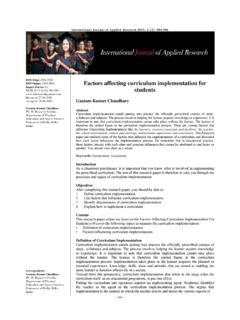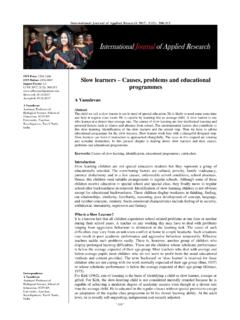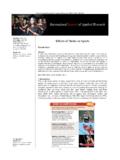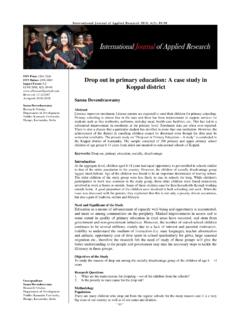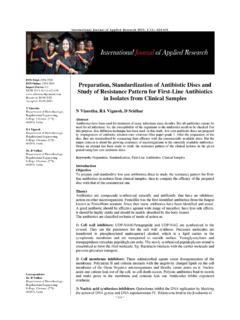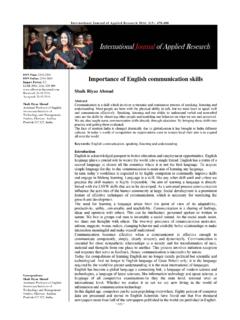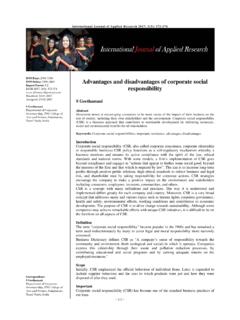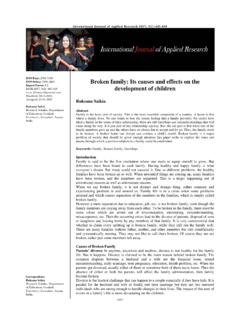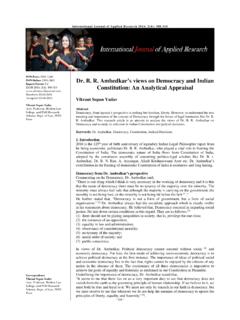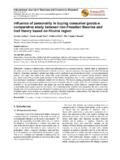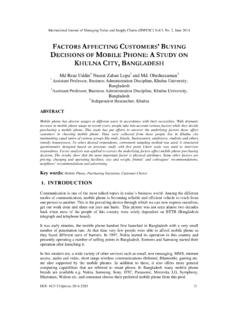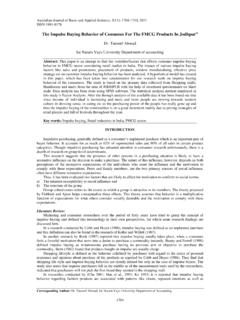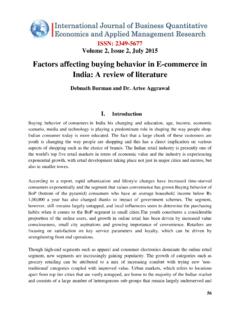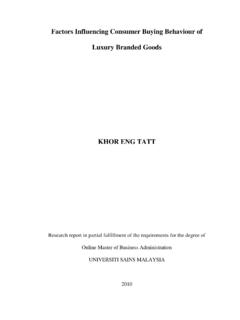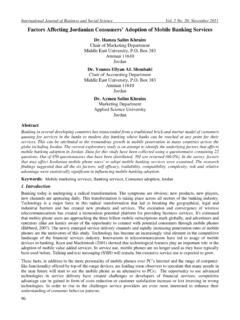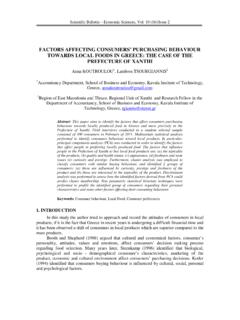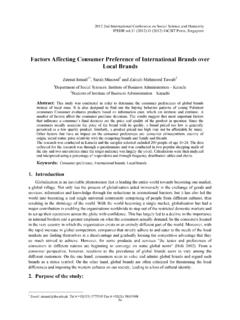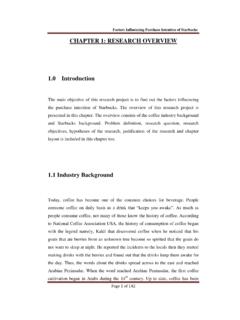Transcription of ISSN Print: Factors affecting consumer buying behavior
1 ~ 76 ~ ISSN Print: 2394-7500 ISSN Online: 2394-5869 Impact Factor: IJAR 2016; 2(10): 76-80 Received: 13-08-2016 Accepted: 14-09-2016 N Ramya Assistant Professor, Department of Commerce with Professional Accounting, Dr. N. G. P. Arts and Science College, Coimbatore 641048, Tamil Nadu, India Dr. SA Mohamed Ali , Professor, CMS Institute of Management Studies, Coimbatore 641049, Tamil Nadu, India Correspondence N Ramya Assistant Professor, Department of Commerce with Professional Accounting, Dr. N. G. P. Arts and Science College, Coimbatore 641048, Tamil Nadu, India Factors affecting consumer buying behavior N Ramya and Dr. SA Mohamed Ali Abstract consumer buying Behaviour refers to the buying behaviour of the ultimate consumer . Many Factors , specificities and characteristics influence the individual in what he is and the consumer in his decision making process, shopping habits, purchasing behavior , the brands he buys or the retailers he goes.
2 A purchase decision is the result of each and every one of these Factors . An individual and a consumer is led by his culture, his subculture, his social class, his membership groups, his family, his personality, his psychological Factors , and is influenced by cultural trends as well as his social and societal environment. By identifying and understanding the Factors that influence their customers, brands have the opportunity to develop a strategy, a marketing message (Unique Value Proposition) and advertising campaigns more efficient and more in line with the needs and ways of thinking of their target consumers, a real asset to better meet the needs of its customers and increase sales. Keywords: Pigeonholing, chunking, law of primacy, socio-economic classification Introduction consumer buying behavior refers to the selection, purchase and consumption of goods and services for the satisfaction of their wants. There are different processes involved in the consumer behavior .
3 Many Factors , specificities and characteristics influence the individual in what he is and the consumer in his decision making process, shopping habits, purchasing behavior , the brands he buys or the retailers he goes. A purchase decision is the result of each and every one of these Factors . Initially the consumer tries to find what commodities he would like to consume, then he selects only those commodities that promise greater utility. After selecting the commodities, the consumer makes an estimate of the available money which he can spend. Lastly, the consumer analyzes the prevailing prices of commodities and takes the decision about the commodities he should consume. Meanwhile, there are various other Factors influencing the purchases of consumer such as social, cultural, economic, personal and psychological. Factors Influencing consumer buying Behaviour The consumer behaviour or buyer behaviour is influenced by several Factors or forces. They are: 1. Internal or Psychological Factors 2.
4 Social Factors 3. Cultural Factors 4. Economic Factors 5. Personal Factors . International Journal of Applied Research 2016; 2(10): 76-80 ~ 77 ~ International Journal of Applied Research There are five questions that support any understanding of consumer behaviour. i) Who is the market and what is the extent of their power with regard to the organisation? ii) What do they buy? iii) Why do they buy? iv) Who is involved in the buying ? v) How do they buy? vi) When do they buy? vii) Where do they buy? The answers of these questions provide the understanding of the ways in which buyers are most likely to respond to marketing stimuli. The stimulus-response model of buyer behaviour is shown below. According to this model, stimuli in the form of both the external environment and the elements of the marketing mix enter the buyer s black box and interact with the buyer s characteristics and decision processes to produce a series of outputs in the form of purchase decisions.
5 The task faced by the marketing planner involves understanding how the black box operates, for which two principal components of the box must be considered; firstly the Factors that the individual brings to the buying situation and secondly the decision processes that are used. The consumer behaviour or buyer behaviour is influenced by several Factors or forces. They are: 1. Internal or psychological Factors The buying behaviour of consumers is influenced by a number of internal or psychological Factors . The most important ones Motivation and Perception. a) Motivation In the words of William J Stanton, A motive can be defined as a drive or an urge for which an individual seeks satisfaction. It becomes a buying motive when the individual seeks satisfaction through the purchase of something . A motive is an inner urge (or need) that moves a person to take purchase action to satisfy two kinds of wants viz. core wants and secondary wants.
6 So, motivation is the force that activates goal-oriented behaviour. Motivation acts as a driving force that impels an individual to take action to satisfy his needs. So it becomes one of the internal Factors influencing consumer behaviour. A need becomes a motive when it is aroused to a sufficient level of intensity. A motive is a need that is sufficiently pressing to drive the person to act. There can be of types of needs: 1. Biogenic needs They arise from physiological states of tension such as thirst, hunger 2. Psychogenic needs They arise from psychological states of tension such as needs for recognition, esteem b) Perception Human beings have considerably more than five senses. Apart from the basic five (touch, taste, smell, sight, hearing) there are senses of direction, the sense of balance, a clear knowledge of which way is down, and so forth. Each sense is feeding information to the brain constantly, and the amount of information being collected would seriously overload the system if one took it all in.
7 The brain therefore selects from the environment around the individual and cuts out the extraneous noise. Therefore the information entering the brain does not provide a complete view of the world around you. When the individual constructs a world-view, she then assembles the remaining information to map what is happening in the outside world. Any gaps (and there will, of course, be plenty of these) will be filled in with imagination and experience. The cognitive map is therefore not a photograph ; it is a construct of the imagination. This mapping will be affected by the following Factors : 1. Subjectivity This is the existing world-view within the individual, and is unique to that individual. 2. Categorisation This is the pigeonholing of information, and the pre-judging of events and products. This can happen through a process known as chunking, whereby the individual organises information into chunks of related items. For example, a picture seen while a particular piece of music is playing might be chunked as one item in the memory, so that sight of the picture evokes the music and vice versa.
8 3. Selectivity This is the degree to which the brain is selecting from the environment. It is a function of how much is going on around the individual, and also of how selective (concentrated) the individual is on the current task. Selectivity is also subjective: some people are a great deal more selective than others. 4. Expectation These lead individuals to interpret later information in a specific way. For example, look at this series of numbers and letters: ~ 78 ~ International Journal of Applied Research In fact, the number 13 appears in both series, but in the first series it would be interpreted as a В because that is what the brain is being led to expect, (The В in Matura Ml Script looks like this. B) 5. Past experience This leads us to interpret later experience in the light of what we already know. Psychologists call this the law of primacy, Sometimes sights, smells or sounds from our past will trigger off inappropriate responses: the smell of bread baking may recall a village bakery from twenty years ago, but in fact the smell could have been artificially generated by an aerosol spray near the supermarket bread counter.
9 An example of cognitive mapping as applied to perception of product quality might run as follows. The consumer uses the input selector to select clues and assign values to them. For quality, the cues are typically price, brand name and retailer name. There are strong positive relationships between price and quality in most consumers perceptions, and brand name and quality; although the retailer name is less significant, it still carries some weight. 2. Social Factors Man is a social animal. Hence, our behaviour patterns, likes and dislikes are influenced by the people around us to a great extent. We always seek confirmation from the people around us and seldom do things that are not socially acceptable. The social Factors influencing consumer behaviour are a) Family, b) Reference Groups, c) Roles and status. a) Family There are two types of families in the buyer s life viz. nuclear family and Joint family. Nuclear family is that where the family size is small and individuals have higher liberty to take decisions whereas in joint families, the family size is large and group decision-making gets more preference than individual.
10 Family members can strongly influence the buyer behaviour, particularly in the Indian contest. The tastes, likes, dislikes, life styles etc. of the members are rooted in the family buying behaviour. The family influence on the buying behaviour of a member may be found in two ways i) The family influence on the individual personality, characteristics, attitudes and evaluation criteria and ii) The influence on the decision-making process involved in the purchase of goods and services. In India, the head of the family may alone or jointly with his wife decides the purchase. So marketers should study the role and the relative influence of the husband, wife and children in the purchase of goods and services. An individual normally lives through two families Family of orientation This is the family in which a person takes birth. The influences of parents and individual s upbringing have a strong effect on the buying habits. For instance, an individual coming form an orthodox Tamil or Gujarati vegetarian family may not consume meat or egg even though she may appreciate its nutritional values.
